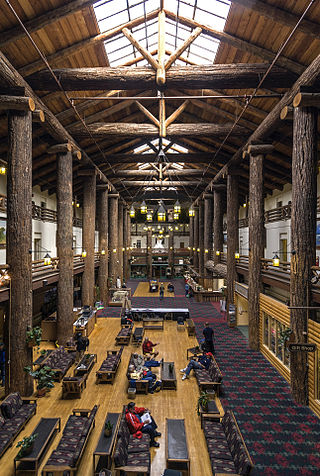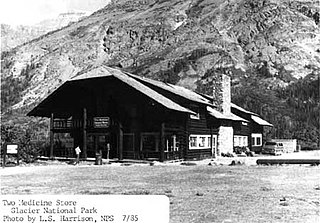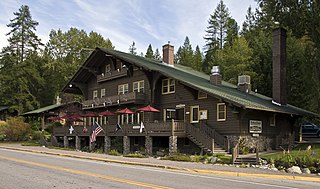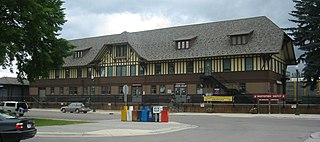Related Research Articles

The Great Northern Railway was an American Class I railroad. Running from Saint Paul, Minnesota, to Seattle, Washington, it was the creation of 19th-century railroad entrepreneur James J. Hill and was developed from the Saint Paul & Pacific Railroad. The Great Northern's route was the northernmost transcontinental railroad route in the U.S.

Glacier National Park is an American national park located in northwestern Montana, on the Canada–United States border, adjacent to Waterton Lakes National Park in Canada—the two parks are known as the Waterton-Glacier International Peace Park. The park encompasses more than 1 million acres (4,000 km2) and includes parts of two mountain ranges, more than 130 named lakes, more than 1,000 different species of plants, and hundreds of species of animals. This vast pristine ecosystem is the centerpiece of what has been referred to as the "Crown of the Continent Ecosystem," a region of protected land encompassing 16,000 sq mi (41,000 km2).

Waterton Lakes National Park is in the southwest corner of Alberta, Canada. The national park borders Glacier National Park in Montana, United States. Waterton was the fourth Canadian national park, formed in 1895 as Kootenay Lakes Forest Reserve. It is named after Waterton Lake, in turn after the Victorian naturalist and conservationist Charles Waterton. Its range is between the Rocky Mountains and prairies. This park contains 505 km2 (195 sq mi) of rugged mountains and wilderness.

The Waterton-Glacier International Peace Park is the union of Waterton Lakes National Park in Canada and Glacier National Park in the United States. Both parks are declared Biosphere Reserves by UNESCO and their union as a World Heritage Site.

The Prince of Wales Hotel is a historic hotel located in Waterton, Alberta, Canada. It is situated within Waterton Lakes National Park, overlooking Upper Waterton Lakes. It was designed by and built for the Great Northern Railway company. It is currently managed by the Pursuit Collection.

The Lake McDonald Lodge is a historic lodge located within Glacier National Park, on the southeast shore of Lake McDonald. The lodge is a 3+1⁄2-story structure built in 1913 based on Kirtland Cutter's design. The foundation and first floor walls are built of stone, with a wood-frame superstructure. The lobby is a large, open space that extends to the third story. It has a massive fireplace and a concrete floor scored in a flagstone pattern, with messages in several Indian languages inscribed into it. The rustic lodge was designated a National Historic Landmark in 1987 as one of the nation's finest examples of large-scale Swiss chalet architecture. Lake McDonald Lodge is a member of Historic Hotels of America, the official program of the National Trust for Historic Preservation.

Many Glacier Hotel is a historic hotel located on the east shore of Swiftcurrent Lake in Glacier National Park in the U.S. state of Montana. The building is designed as a series of chalets, up to four stories tall, and stretches for a substantial distance along the lakeshore. The building has a Swiss alpine theme both on the outside and on the inside. The foundation is made of stone, with a wood superstructure. The outside is finished with brown-painted wood siding, and the window framing and balconies have wood sawed in Swiss jigsawed patterns. On the inside, the four-story lobby is surrounded by balconies, whose railings are patterned after Swiss designs.

Glacier Park Lodge is located just outside the boundaries of Glacier National Park in the village of East Glacier Park, Montana, United States. The lodge was built in 1913 by the Glacier Park Company, a subsidiary of the Great Northern Railway. It was the first of a series of hotels built in and near Glacier National Park by the Great Northern to house visitors brought to the park by the railroad.

Sperry Chalet is located about seven miles east of Lake McDonald in Glacier National Park in the U.S. state of Montana. The chalet was opened in 1914 by the Great Northern Railway and was a National Historic Landmark contributing property, being one of five structures in the Great Northern Railway Buildings National Historic Landmark. Along with Granite Park Chalet, Sperry Chalet is one of the two remaining backcountry chalets in Glacier National Park, both operated by Belton Chalets, Inc.

Two Medicine Store, formerly part of Two Medicine Chalets, is a historic building in Glacier National Park in the U.S. state of Montana. The chalet was originally built in 1914 by the Glacier Park Hotel Company, a subsidiary of the Great Northern Railway, as part of the railway's extensive program of visitor services development at Glacier. The chalet group originally featured a complex of log buildings, all built in the rustic style, which provided dining and lodging facilities. Overnight accommodations at the chalet ended with the onset of World War II, and the other buildings at the site were intentionally burned in 1956.

National Park Service rustic – sometimes colloquially called Parkitecture – is a style of architecture that developed in the early and middle 20th century in the United States National Park Service (NPS) through its efforts to create buildings that harmonized with the natural environment. Since its founding in 1916, the NPS sought to design and build visitor facilities without visually interrupting the natural or historic surroundings. The early results were characterized by intensive use of hand labor and a rejection of the regularity and symmetry of the industrial world, reflecting connections with the Arts and Crafts movement and American Picturesque architecture.

The Belton Chalets are a group of historic hotel buildings in the village of West Glacier, Montana, near the western entrance to Glacier National Park. The chalet buildings were built in 1910-11 by the Great Northern Railway (GN) as the first component of the railroad's ambitious program of hotel, road, and trail construction in Glacier. The buildings featured a "Swiss Chalet" architectural style that set the style for much of the Great Northern's building program in Glacier. Ultimately, the site included five buildings, including a dining hall and a hotel facility.

Viad Corp provides experiential leisure travel and face-to-face events in the United States, Canada, the United Kingdom, Europe, and the United Arab Emirates via two divisions: GES and Pursuit.

Whitefish station is a stop on Amtrak's Empire Builder in Whitefish, Montana. In addition to the Empire Builder, a once-daily Greyhound Lines bus service also links the station to Kalispell and Missoula. A car rental agency operates a window within the station. The station and parking lot are owned by the Stumptown Historical Society. BNSF Railway leases office space on the upper floors of the station and owns the platform and track.
Babb is a small unincorporated farming and ranching community in Glacier County, Montana, United States, on the Blackfeet Indian Reservation. The community experiences a large influx of tourists in the summer months as it is the gateway to the Many Glacier area of Glacier National Park. For statistical purposes, the United States Census Bureau has defined Babb as a census-designated place (CDP). It had a population of 174 at the 2010 census.

The Great Northern Railway Buildings are a set of five building complexes in or near Glacier National Park in Montana. They were built by the Great Northern Railway during the period of the park's founding to provide a unified tourist experience to visitors to the park, using the Swiss chalet as a building model. The building complexes, each separately listed on the National Register of Historic Places, are:

The Swiftcurrent Auto Camp Historic District preserves a portion of the built-up area of Glacier National Park that documents the second phase of tourist development in the park. After the creation of a series of hotels for train-borne visitors including the nearby Many Glacier Hotel, courtesy of the Great Northern Railway's hotel concession, facilities were developed for the increasing numbers of automobile-borne tourists, drawn to Glacier by the Going-to-the-Sun Road. The Swiftcurrent Auto Camp at Swiftcurrent Lake was created for these new tourists. It includes a rustic general store, built in 1935 by the Glacier Park Hotel Company, surrounded by a number of log tourist cabins., as well as a shower and laundry house and other supporting structures.

The List of Glacier National Park (U.S.) references identifies English language historic, scientific, ecological, cultural, tourism, social, and advocacy books, journals and studies on the subject of Glacier National Park (U.S.) topics published since 1870 and documented in Glacier related bibliographies and other related references.

Harry W. Child (1857–1931) was an entrepreneur who managed development and ranching companies in southern Montana. He was most notable as a founder and longtime president of the Yellowstone Park Company, which provided accommodation and transportation to visitors to Yellowstone National Park from 1892 to 1980. Child was, with park superintendent and National Park Service administrator Horace Albright, singularly responsible for the development of the park as a tourist destination and for the construction of much of the park's visitor infrastructure.

Louis Warren Hill, was an American railroad executive. He was the president and board chairman of the Great Northern Railway, which served a substantial area of the Upper Midwest, the northern Great Plains, and Pacific Northwest.
References
- ↑ Mayes, Steve (December 28, 1990). "Old railyard requires major soil cleanup". The Oregonian . Portland. p. D1.
- Djuff, Ray, and Chris Morrison. View with a Room: Glacier's Historic Hotels and Chalets. Helena, Montana: Farcountry Press, 2001. ISBN 1-56037-170-6.
- Ober, Michael J. "Enmity and Alliance: Park Service-Concessioner Relations in Glacier National Park, 1892-1961." MA Thesis, University of Montana, 1973.